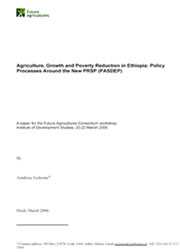{jathumbnail off} “Agriculture is the mainstay of the Ethiopian Economy”. This statement has almost become acliché for development professionals in Ethiopia. Those who went to school 50 years ago,read it; and later on wrote about it. So has the present generation. The Report on the Ethiopian Economy, Volume IV (EEA/EEPRI, 2004/05:10) stated, for example:“…agriculture is the main stay of the Ethiopian economy and the most volatile sector….mainly due to its dependence on rain and the seasonal shocks that are frequently observed”.
“Agriculture is the mainstay of the Ethiopian Economy”. This statement has almost become acliché for development professionals in Ethiopia. Those who went to school 50 years ago,read it; and later on wrote about it. So has the present generation. The Report on the Ethiopian Economy, Volume IV (EEA/EEPRI, 2004/05:10) stated, for example:“…agriculture is the main stay of the Ethiopian economy and the most volatile sector….mainly due to its dependence on rain and the seasonal shocks that are frequently observed”.
As things stand, our children and grandchildren will be repeating this refrain for generations to come. Yet, the sector has been unable to realise its potential and contribute significantly to economic development. How can we change this? In the Ethiopian context, agriculture is proving to be the most complex sector to understand. On the one hand, it contributes the largest share to GDP, export trade and earnings, and employs 84% (PASDEP, 2006) of the population.
On the other hand, despite such socio-economic importance, the performance of the sector is very low due to many natural and man-made factors. As a result, Ethiopia is characterised by large food self-sufficiency gap atnational level and food insecurity at household level (EEA/EEPRI, 2004/05:145). Whereas in the Northern highlands, farmers struggle to make ends meet on completely degraded land, in the South and Southwestern part of the country, people live in extremepoverty in the midst of plenty – fertile land and relatively preserved environment.
Tocomplicate matters further, the country’s future is pinned on agriculture as demonstrated in a statement by the Prime Minister of Ethiopia in 2000.
